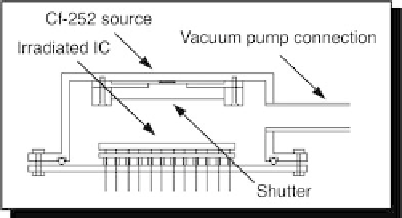Hardware Reference
In-Depth Information
Fig. 8.11
Cross-sectional
view of the miniature vacuum
chamber
to compare these techniques by running experiments on the same testbed architec-
ture and a common test scenario. The results of these experiments are presented in
8.3.2.1
Heavy-Ion Radiation
The fault injection experiments with heavy-ion radiation (HI, for short) were carried
out at Chalmers University of Technology in Goteborg, Sweden. A Californium-252
source can be used to inject single event upsets, i.e., bit-flips at internal locations
of a target IC using a miniature vacuum chamber. Figure
8.11
depicts the cross-
sectional view of the miniature vacuum chamber. The pins of the target IC are
extended through the bottom plate of the vacuum chamber, so that the chamber
with the circuit can be directly plugged into the socket of the circuit under test. The
vacuum chamber contains an electrically controlled shutter, which is used to shield
the circuit under test from radiation during bootstrapping.
A major feature of the HI injection technique is that faults can be injected into
VLSI circuits at locations that are difficult (and mostly impossible) to reach by other
techniques. The transient faults produced are also reasonably well spread at random
locations within an IC, as there are many sensitive memory elements in most VLSI
circuits. As device feature size of integrated circuits is shrinking, radiation induced
bit-flips, also known as
soft errors
, constitute an increasingly important source of
The percentage of multiple bit errors induced in the main registers was found to be
8.3.2.2
Pin-Level Fault Injection
The experiments with the pin-level fault injection technique were conducted at
LAAS-CNRS, in Toulouse, France using the MESSALINE tool. Figure
8.12
de-
picts the principle of the pin-forcing technique (PF). In this case, the fault is directly
applied on the pin(s) of the target IC.

